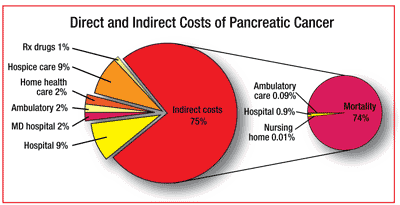US Pharm. 2010;35(9)(Oncology suppl):17.
In 2009, 42,470 new cases of pancreatic cancer and 35,240 deaths due to pancreatic cancer were reported. The overall risk of having pancreatic cancer in one’s lifetime is 1 in 72. Even though extensive research efforts are ongoing, scientists do not know exactly what causes most pancreatic cancers. However, some risk factors that affect the DNA of cells in the pancreas have been identified. Treatments being developed include the use of drugs that block tumor growth by starving the tumor and boosting the immune system through the use of synthetic monoclonal antibodies.

Diagnosis: In 2004, 71% of newly diagnosed pancreatic cancers were in individuals aged 65 or more years. Age at diagnosis was higher than in most other digestive-system cancers, with the median age being 72 years and diagnosis at age 75 or more years occurring at a rate of 40%.
Incidence: The incidence of pancreatic cancer was higher among the elderly, at 63.4/100,000 for age 65 or more years. Incidence was the same in non-Hispanic blacks and in males (10.6/100,000). Incidence remained relatively stable from 1979 to 2004.
Survival: Survival of pancreatic cancer is the poorest of any major cancer or digestive system disorder. Nevertheless, 5-year survival increased modestly from 2% in patients diagnosed in 1979 to 3.8% in those diagnosed in 1999, according to the latest data released by the National Centers for Health Statistics.
Ambulatory Care and Hospitalizations: In 2004, there were 415,000 ambulatory care visits and 68,000 hospital discharges with a diagnosis of pancreatic cancer. The hospitalization rate was highest among the elderly, and rates were high for black patients and males. While ambulatory care visits increased from 1992 through 2004, hospital discharge rates remained stable from 1979 through 2004.
Mortality: Because of the low probability of survival, the rate of mortality due to pancreatic cancer was the same as in 2004. There were 31,800 deaths in 2004 and 206,800 years of potential life lost to age 75 years. The mortality rate was highest in the oldest age group. The mortality rate was higher for black patients and for males. Death rates for pancreatic cancer remained steady between 1979 and 2004.
Costs: The total cost associated with pancreatic cancer was $4.3 billion. The direct cost was $1.1 billion, divided among hospital (39%), hospice care (35%), home health care (9%), ambulatory care (7%), physician hospital (6%), prescription drugs (3%), and nursing home (1%). The indirect cost of pancreatic cancer was $3,226 million, of which 98% was attributable to mortality, 1.7% to hospital stay, and 0.3% to ambulatory care.
To comment on this article, contact rdavidson@uspharmacist.com.





